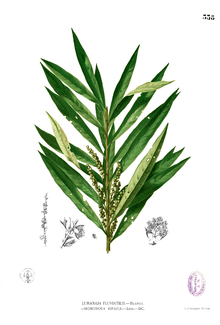Homonoia riparia
| Willow-Leaved Water Croton | |
|---|---|
 | |
| Homonoia riparia[1] | |
| Scientific classification | |
| Kingdom: | Plantae |
| (unranked): | Angiosperms |
| (unranked): | Eudicots |
| (unranked): | Rosids |
| Order: | Malpighiales |
| Family: | Euphorbiaceae |
| Subfamily: | Acalyphoideae |
| Tribe: | Acalypheae |
| Subtribe: | Lasiococcinae |
| Genus: | Homonoia |
| Species: | H. riparia |
| Binomial name | |
| Homonoia riparia Lour. | |
| Synonyms | |
| |
The Willow-Leaved Water Croton,[3] (Homonoia riparia), a mangrove species, belongs to the genus Excoecaria of the family Euphorbiaceae. The plant is widely distributed through South Asian and South East Asian countries such as Cambodia, China, Indonesia, Laos, Papua New Guinea, Philippines, Sri Lanka, Taiwan, Thailand and Vietnam. It is grown in wet soil near river banks and flooded plains.[4]
Description
- Bark - brownish
- Leaves - simple, and alternate
- Flowers - wind pollinated monoecious flowers and bracts sub-ovate
- Height - 1–3-metre-tall evergreen shrub
- Ecology - A rheophyte
- Uses - medicine
Common Names
The names are according to Asian Plant.net and Indian Flowers
- Borneo - Bongai tidong, Parang-parang
- Burma - Kyauk(a)naga, Momaka, Nyin ye bin.
- Cambodia - Rey tuck.
- China - Shui liu, shui yeung mui.
- English - Willow-Leaved Water Croton.
- India
- Hindi - Sherni (शेरनी)
- Marathi - Raan kaner (रान कणेर)
- Tamil - Kattalari (காட்டலரி)
- Malayalam - Neervanchi, Puzhavanchi
- Telugu - Adavi ganneru (అడవి గన్నేరు)
- Kannada - Hole nage, Niru kanigalu (ಹೊಳೆ ನಗೆ)
- Sanskrit - Kshudrapashanabheda (क्षुद्रपाषाणभेद)
- Java - Kajoe soebah, Keding djati, Soebah/Sobah,
- Laos - Kek khay.
- Philippines - Agooi, Agoioi, Agukuk,
- Thailand - K(l)ai nam , Klai hin, Mai kerai, (Ta)kri nam.
- Sri Lanka - Omi (ඕමි), Werawala (වැරවල)
- Sumatra - Sangka, Sangkir
- Vietnam - Cây rù rì nuóc, Rì rì, Rù rì.
References
- ↑ 1880 illustration from Francisco Manuel Blanco (O.S.A.) - Flora de Filipinas
- ↑ http://www.theplantlist.org/tpl/record/kew-100133
- ↑ http://www.iucnredlist.org/details/176888/0
- ↑ http://www.biotik.org/india/species/h/homoripa/homoripa_en.html
Further reading
- Yang, SM; Liu, XK; Qing, C; Wu, DG; Zhu, DY (2007). "Chemical constituents from the roots of Homonoia riparia". Yao Xue Xue Bao. 42: 292–6. PMID 17520829.
External links
- http://www.asianplant.net/Euphorbiaceae/Homonoia_riparia.htm
- Study of chemical constituents of the leaves of Homonoia riparia
This article is issued from Wikipedia - version of the 5/24/2016. The text is available under the Creative Commons Attribution/Share Alike but additional terms may apply for the media files.
